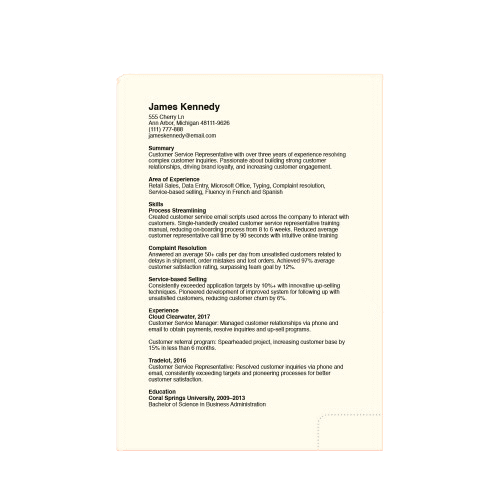What sections should I include in my resume?
A well-organized resume that includes the most important sections can get you noticed by hiring the manager and land you a job. While every resume is different, there are standard sections you should include and others that are optional.
To ensure your resume stands out from the rest, it’s crucial to include the right sections that paint a compelling picture of who you are. In this article, we will delve into the standard sections that you should include and the optional ones.
5 Standard sections of a resume

1. Contact Information:
The first section of your resume, and perhaps the most underrated, is your contact information. Imagine a recruiter being impressed by your skills but struggling to find your contact details. Don’t let that happen. Ensure your full name, phone number, and professional email address are prominently displayed. Include links to your LinkedIn profile or portfolio for an added professional touch.
An example of contact information to include
- Full Name
- Phone Number
- Email Address
- LinkedIn Profile (optional)
- Professional Website or Portfolio (if applicable)
2. Resume Summary or Objective:
This is a two- or four statement that tells the hiring manager why you qualify for the job. It should be a concise statement that captures your career goals, core skills, and what makes you uniquely qualified for the job. This is the section where you should aim to grab the hiring manager’s attention from the get-go.
An example of a summary
Results-driven marketing professional with over 5 years of experience in developing and executing strategic marketing campaigns for global tech companies. Proven track record of driving brand awareness and increasing lead generation by 30%. Expertise in digital marketing, content creation, and data analysis. I am seeking to leverage my skills to propel XYZ Company's marketing initiatives to new heights.
3. Showcasing Your Skills
Skills are also known as your core strength or core competence. Here, you create a dedicated section that highlights both technical and soft skills that are relevant to the position you are applying for. Use keywords that are used on the job application to align with the needs of employers. However, don’t overdo it.
Note: You should include 1–10 skills that are relevant to the job description.
Examples of Soft and technical skills
- Communication
- Team Work
- Leadership
- Web Developer
- Data analyst
4. Work Experience:
The work experience section is the heart of your resume. It provides a chronological overview of your career. List the names and locations of your former employers, your job title, and the period of time you worked there. Start with your most recent role and detail your key responsibilities and achievements. Quantify your impact whenever possible, showcasing how your contributions have made a tangible difference. This section should tell a story of progression, competence, and value.
Examples of work experience include:
- Start with your most recent job and work backward.
- Include the following for each position:
- Job Title
- Company Name
- Location (city, state)
- Dates of Employment (start and end dates)
- Bullet points describe your key responsibilities and achievements.
5. Education:
List your educational background with a focus on relevance to the job. Include your degree, diploma (if applicable), school name, graduation date, and GPA (if strong). This section assures employers that you have the foundational knowledge and commitment to excel in your field.
The details you should include
Include the following for each entry:
- Degree Earned
- Certificate or degree (if applicable)
- School Name
- Graduation Date
- GPA (if it’s strong and recent; otherwise, it’s optional)
Optional parts of your resume
1. Certifications and Projects
Showcase your additional qualifications, certifications, and noteworthy projects. In this sections you demonstrate your commitment to continuous learning, innovation, and a proactive approach to your professional development.
Example
- List any relevant certifications you have obtained.
- Describe any relevant projects you’ve worked on. This could include personal projects, academic projects, or work-related projects.
2. Awards, Memberships, and Languages
Round out your resume with sections that add depth to your profile. Highlight any awards or honors, professional memberships, and proficiency in languages. These details not only enhance your credibility but also provide a more holistic view of who you are as a candidate.
- Mention any awards or honors you’ve received that are relevant to your field.
- List any professional organizations you are a member of.
- Specify any languages you are proficient in, especially if it’s relevant to the job.
3. Volunteer Experience:
If you have voluntereed to any job make sure to include in this section. While this section is not a must, it offers insights to the recruiting manager about your character, values and community engagement. It also demonstrates a commitment beyond the workplace, revealing qualities that you have like empathy, teamwork, and a desire to make a positive impact.
Example
- Include any volunteer work that is relevant to your career or demonstrates valuable skills.
4. Hobbies/Interests:
Humanize your resume and provide a glimpse of your personality beyond the professional realm. Consider including activities that highlight qualities valued in the workplace, such as leadership, creativity, or teamwork. Remember, this section can be a conversation starter during interviews, making you a memorable candidate.
Example
- Consider adding a brief section about your hobbies or interests, especially if they showcase skills or traits relevant to the job.
5. The Final Touch: References Available Upon Request
End your resume with a note about references. While it’s not necessary to include them on the document, mentioning that references are available upon request indicates your preparedness and willingness to provide additional validation of your qualifications.
- References available upon request is sufficient. Avoid including actual references on your resume, but be prepared to provide them when asked.







